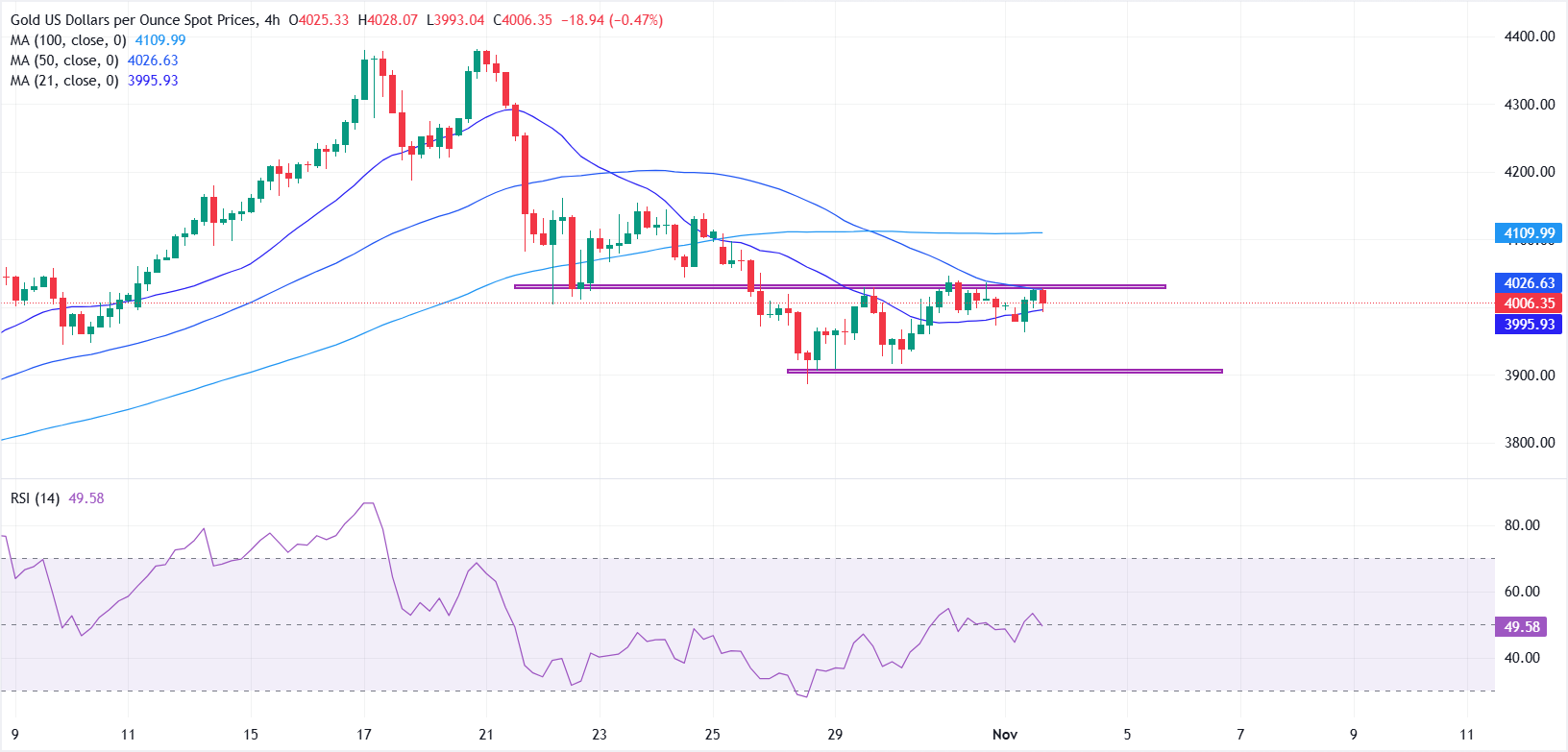Created
: 2025.11.03














![]() 2025.11.03 21:04
2025.11.03 21:04
Gold (XAU/USD) kicks off the week on a cautious footing, oscillating within its established $3,900-$4,050 range as traders weigh an evolving macroeconomic backdrop. At the time of writing, XAU/USD is trading around $4,008 after briefly slipping to $3,962 earlier in the Asian session.
Gold struggles to attract follow-through buying as the US Dollar (USD) remains broadly supported by the Federal Reserve's (Fed) hawkish tilt. The central bank lowered interest rates by 25-basis-points (bps) at last week's Federal Open Market Committee (FOMC) meeting but signaled that further easing this year is unlikely. This stance has lifted the Greenback across the board, with traders scaling back expectations of another rate cut in December.
At the same time, improving risk appetite and firmer global equities limit Bullion's upside potential. The de-escalation in the US-China trade conflict has reduced demand for traditional safe-haven assets for now. However, the broader trend still tilts to the upside, underpinned by sustained institutional demand and persistent geopolitical and economic uncertainty that continue to anchor long-term support for the precious metal.

Gold lacks clear directional momentum, trading within a narrow range and stuck between key short-term moving averages on the 4-hour chart. The 50-period Simple Moving Average (SMA), near $4,026, continues to cap the upside and aligns with a former support-turned-resistance zone around $4,020-$4,050.
On the downside, the 21-period SMA at $3,996 offers immediate support. A break below this level could expose the $3,900 area, where dip-buying interest is likely to re-emerge.
Conversely, a decisive move above the confluence of the 50-SMA and horizontal resistance would open the door toward the $4,100-$4,150 region. The Relative Strength Index (RSI) stands at 49, reflecting a neutral bias and confirming the market's lack of conviction in either direction.
Gold has played a key role in human's history as it has been widely used as a store of value and medium of exchange. Currently, apart from its shine and usage for jewelry, the precious metal is widely seen as a safe-haven asset, meaning that it is considered a good investment during turbulent times. Gold is also widely seen as a hedge against inflation and against depreciating currencies as it doesn't rely on any specific issuer or government.
Central banks are the biggest Gold holders. In their aim to support their currencies in turbulent times, central banks tend to diversify their reserves and buy Gold to improve the perceived strength of the economy and the currency. High Gold reserves can be a source of trust for a country's solvency. Central banks added 1,136 tonnes of Gold worth around $70 billion to their reserves in 2022, according to data from the World Gold Council. This is the highest yearly purchase since records began. Central banks from emerging economies such as China, India and Turkey are quickly increasing their Gold reserves.
Gold has an inverse correlation with the US Dollar and US Treasuries, which are both major reserve and safe-haven assets. When the Dollar depreciates, Gold tends to rise, enabling investors and central banks to diversify their assets in turbulent times. Gold is also inversely correlated with risk assets. A rally in the stock market tends to weaken Gold price, while sell-offs in riskier markets tend to favor the precious metal.
The price can move due to a wide range of factors. Geopolitical instability or fears of a deep recession can quickly make Gold price escalate due to its safe-haven status. As a yield-less asset, Gold tends to rise with lower interest rates, while higher cost of money usually weighs down on the yellow metal. Still, most moves depend on how the US Dollar (USD) behaves as the asset is priced in dollars (XAU/USD). A strong Dollar tends to keep the price of Gold controlled, whereas a weaker Dollar is likely to push Gold prices up.
![]()
Created
: 2025.11.03
![]()
Last updated
: 2025.11.03

FXStreet is a forex information website, delivering market analysis and news articles 24/7.
It features a number of articles contributed by well-known analysts, in addition to the ones by its editorial team.
Founded in 2000 by Francesc Riverola, a Spanish economist, it has grown to become a world-renowned information website.
We hope you find this article useful. Any comments or suggestions will be greatly appreciated.
We are also looking for writers with extensive experience in forex and crypto to join us.
please contact us at [email protected].
Disclaimer:
All information and content provided on this website is provided for informational purposes only and is not intended to solicit any investment. Although all efforts are made in order to ensure that the information is correct, no guarantee is provided for the accuracy of any content on this website. Any decision made shall be the responsibility of the investor and Myforex does not take any responsibility whatsoever regarding the use of any information provided herein.
The content provided on this website belongs to Myforex and, where stated, the relevant licensors. All rights are reserved by Myforex and the relevant licensors, and no content of this website, whether in full or in part, shall be copied or displayed elsewhere without the explicit written permission of the relevant copyright holder. If you wish to use any part of the content provided on this website, please ensure that you contact Myforex.
Myforex uses cookies to improve the convenience and functionality of this website. This website may include cookies not only by us but also by third parties (advertisers, log analysts, etc.) for the purpose of tracking the activities of users. Cookie policy